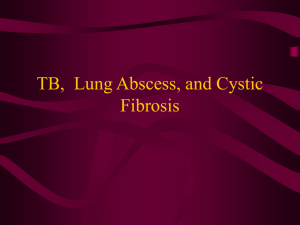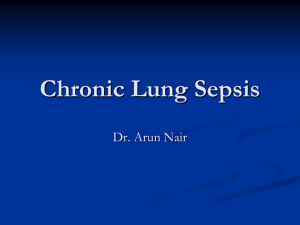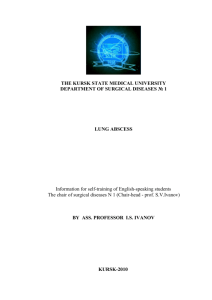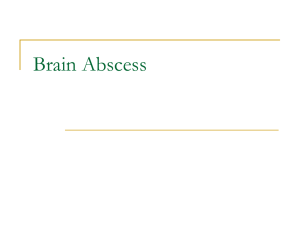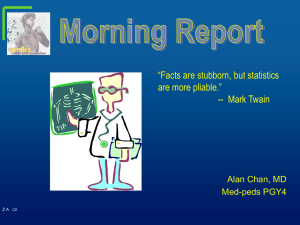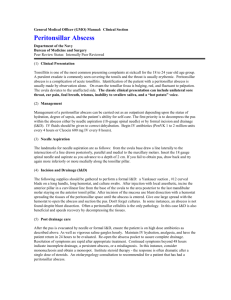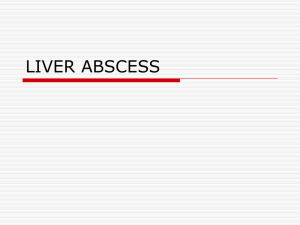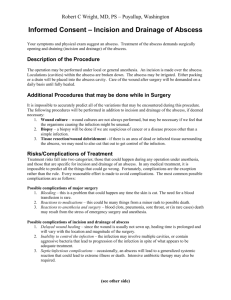Lung Abscess
advertisement
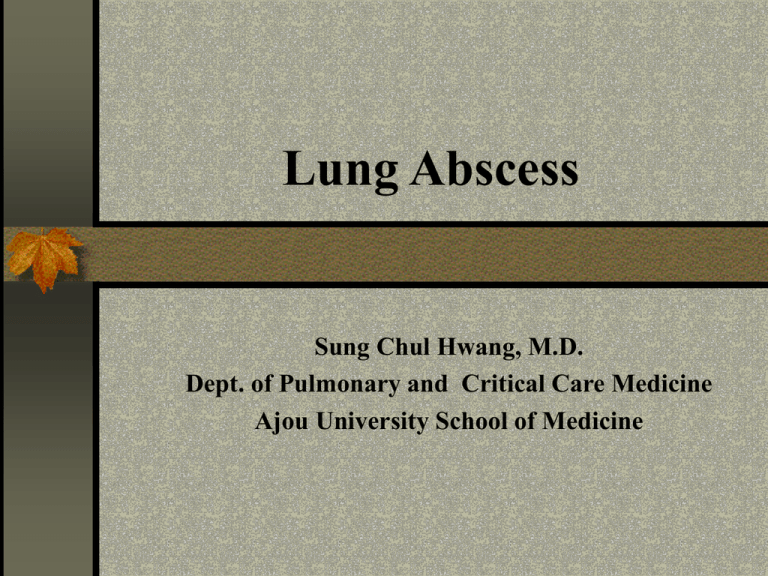
Lung Abscess Sung Chul Hwang, M.D. Dept. of Pulmonary and Critical Care Medicine Ajou University School of Medicine Definition Infection of the lung parenchyme consisting of one or more necrotic inflammatory cavities, containing fibropurulent exudates and gaseous materials Etiology of Lung Abscess Aspiration : seizure, coma, surgery, DM, sedatives, alcohol, neurologic diseases Bronchial obstruction : malignancy, F.B. Septic emboli : SBE, catheters, prostheses, pelvic thrombophlebitis Direct Spread : subphrenic, hepatic Pneumonia complication : S. aureus, Klebsiella, pseudomonas, etc Classifications Duration Causes Acute < 4-6 week Primary Chronic Secondary Symptoms of Lung Abscess Cough : 77% Sputum : 65% Fever and chills : 40% Chest pain : 24% Hemoptysis : 16% Dyspnea : 15% Anorexia : 4% Night sweats : 1 % Aspiration Abscess Most common cause Tosillectomy, seizure, neurosurgery, alcoholism, etc Organism identification in only 30-40% Mostly Anarobic, mixed organisms “Putrid sputa” Dependent portions: Lowerlobe,posteior & lateral basal seg. Upper lobe, posterior seg. Usually single abscess cavity Necrotizing Pneumonia Community :Staph. Aureus or Klebsiella Hospital : Pseudomonas or Proteus Aspiration pneumonias cause necrotizing infections Klebsiella predominant in alcoholics or DM Secondary to Malignancy Bronchogenic cancer : Squamous Ca Lymphoma Leukemia Multiple Myeloma Metastatic Malignancies Diagnosis X-ray : Cavity with “air-fluid level” CBC : leukocytosis, Anemia , etc Cultures : Sputum & Blood Anaerobic culture is important Chest CT Sputum cytology Sputum AFB Bronchoscopy or NAB to Rule out malignancy Treatment Medical treatment is the mainstay Pennicillin, Cephalosporin Clindamycin, chloramphenicol, Metronidazole to cover for the Anarobes Postural drainage Bronchoscopic drainage Indications for Surgery Massive hemoptysis Refractory to Medical treatment Large cavity with thick walls Complicated by malignancy Empyema develops Chronicity, Recurrence Remaining residual cavity Prognosis Relatively Favorable Underlying Disease is important Operation Rate : 15% Overall mortality rate : 10% Empyema Mainly Surgical disease Presence of Pus or demonstrable Micro- organisms such as, Bacteria, mycobacterium, or fungus in pleural cavity Closed Drainage Pig-tail catheter insertion with intra-pleural urokinase instillation Surgical drainage with empymectomy : conventional surgery or VATS Lung Abscess Cavity with “Air-Fluid level” Lung Abscess Left Upper Lobe Posterior Segment Lung Abscess Pseudomonas Lung Abscess Lung Abscess Malignant Abcess Cavity Septic Pneumonia mMultiple Bilateral Septic Emboli u Septic Emboli Septic Emboli in Pulmonary arteries : H & E Empyema Empyema Empyema pus diaphragm Indication for Pneumococcal Vaccination (Polyvalent) >65 years Chronic Cardiac conditions Chronic Lung Diseases Asplenia Chronic Liver Diseases Alcoholism DM Chronic Renal Failure Hodgkin’s Disease Leukemia, Multiple myeloma Chronic hemodialysis HIV Infection
